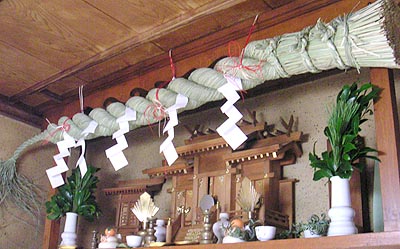Kamidana on:
[Wikipedia]
[Google]
[Amazon]
 are miniature household altars provided to enshrine a
are miniature household altars provided to enshrine a
File:Kamidana2.jpg, alt=A small pinewood shrine, featuring a plain torii gate decorated with streamers, a small mirror in front of a cup, and a blue daruma doll., A personal
File:Kamidana with kagamimochi offering by shig2006 in Hitachinaka.jpg, alt=A large, darkwood altar, featuring paper and wooden sticks with kanji tied together with mizuhiki cord, behind two stacked rice cakes with a satsuma balanced on top., A larger household
File:Toei Uzumasa-0347.jpg, alt=A large, decorative alcove shrine, with red paper lanterns decorated with black text strung across the top, a miniature torii gate in front and two red daruma dolls at either side., A decorative
File:Name-the-baby&household-Shinto-altar,japan.JPG, alt=A wooden household shrine featuring two tĹŤrĹŤ lanterns made of wood, and a piece of paper announcing the name of a baby., A celebrating the naming of a baby
File:Sacred straw rope at New Year's,shimenawa,katori-city,japan.jpg, with
 are miniature household altars provided to enshrine a
are miniature household altars provided to enshrine a Shinto
, also called Shintoism, is a religion originating in Japan. Classified as an East Asian religions, East Asian religion by Religious studies, scholars of religion, it is often regarded by its practitioners as Japan's indigenous religion and as ...
. They are most commonly found in Japan
Japan is an island country in East Asia. Located in the Pacific Ocean off the northeast coast of the Asia, Asian mainland, it is bordered on the west by the Sea of Japan and extends from the Sea of Okhotsk in the north to the East China Sea ...
, the home of worship.
The is typically placed high on a wall and contains a wide variety of items related to Shinto-style ceremonies, the most prominent of which is the , an object meant to house a chosen , thus giving it a physical form to allow worship. are most commonly small circular mirrors, though they can also be jewels, or some other object with largely symbolic value. The within the is often the deity of the local shrine or one particular to the house owner's profession. A part of the () was obtained specifically for that purpose from a shrine through a process called .
Worship at the typically consists of the offering of simple prayers, food (e.g., rice, fruit, water) and flowers. Before worshipping at the , it is ritually important for family members to cleanse their hands or mouth.
can also be found in some traditional Japanese martial art
Japanese martial arts refers to the variety of martial arts native to the country of Japan. At least three Japanese terms (''budĹŤ'', ''bujutsu'', and ''bugei'') are used interchangeably with the English phrase Japanese martial arts.
The usage ...
s dojo
A is a hall or place for immersive learning, experiential learning, or meditation. This is traditionally in the field of martial arts. The term literally means "place of the Tao, Way" in Japanese language, Japanese.
History
The word ''dĹ ...
s.
Acquisition and care
A household is typically set up in one's home to enshrine an , a type of charm. Both and can be obtained at any largeShinto shrine
A Stuart D. B. Picken, 1994. p. xxiii is a structure whose main purpose is to house ("enshrine") one or more kami, , the deities of the Shinto religion.
The Also called the . is where a shrine's patron is or are enshrined.Iwanami Japanese dic ...
. by themselves can be displayed on a counter or anywhere visible, provided that they are kept in their protective pouches. However, when an is enshrined in a , there are several rules which must be followed to ensure proper installation.
# First, a cannot be set up on the ground or at eye level. It must be above an ordinary person's eye level.
# Second, a cannot be set up over an entrance; it must be built into a space which people will not walk under.
# Finally, when an is enshrined in a , after removing the pouch it is customary to leave an offering of water, liquor
Liquor ( , sometimes hard liquor), spirits, distilled spirits, or spiritous liquor are alcoholic drinks produced by the distillation of grains, fruits, vegetables, or sugar that have already gone through ethanol fermentation, alcoholic ferm ...
, or food in front of the , which should be renewed regularly. Water, for example, is stored in a small, droplet-shaped vessel called a .
These rules apply both to one's household and to martial arts dojos.
are replaced before the end of each year. However, can be kept in one's house until they are no longer usable.
Examples
See also
* – analogous concept in Japanese Buddhism * Etiquette in Japan * * * Spirit house * - also called , , or *Notes
References
Bibliography
* Ono, Sokyo, ''Shinto: The Kami Way'', Charles E. Tuttle Company, {{Japanese architectural elements Altars Japanese architectural features Japanese home Shinto Shinto religious objects Japanese words and phrases